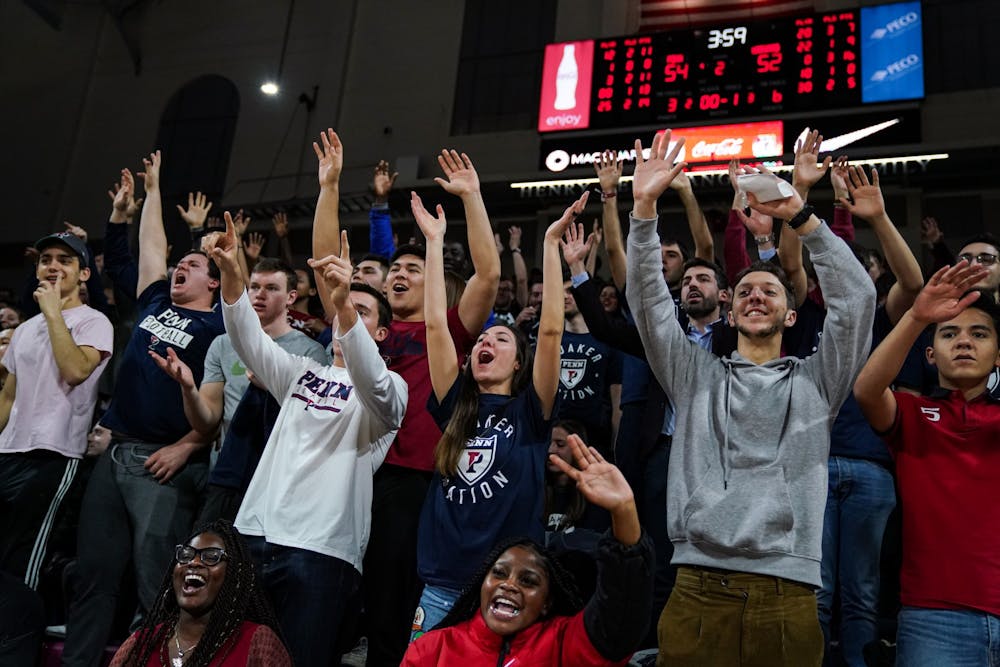
A changing campus culture is likely the reason behind why the number of students at Penn basketball games has dwindled in recent years.
Credit: Chase SuttonI was there the day The Line died. To be more accurate, I was The Line the day The Line died.
For decades, The Line was the tradition of Penn students camping out the night before Penn men's basketball tickets went on sale. Not only was it an opportunity to snag the best seats in the house for that season, The Line also provided an opportunity to bond with fellow sports fanatics.
Well, when I showed up at 6 a.m. on the morning of The Line in 2012, there was no one else there. I peered into the Palestra. Nothing. So I waited, contemplating whether I'd gotten the date wrong before someone else joined over an hour later.
I got my choice of seats, but I was immediately dissuaded of any notion that Penn basketball reigned supreme on campus. As pointed out by The DP's writers and Editorial Board last week, that enthusiasm has remained somnambulant in the near-decade since.
Unlike other Penn alums, I'm not here to chastise the next generation for not attending games. I understand. The reasons are plentiful and go beyond the questionable reasons provided by the student body in this week's article. (A two-hour basketball game is not too long; you just don't like basketball, and that's OK.)
Penn does not have the basketball program my mother saw make the Final Four her senior year. The recruiting rules are different, and the Quakers aren't a national basketball brand.
Even if you flash forward to the 1990s, Penn still faces an entirely new landscape from then. The Quakers of that era mostly had to worry about Princeton and the occasional one-off contender. Now, Yale and Harvard have established themselves as basketball forces. The Ancient Eight is still top-heavy, but the conference has twice the competition. Perhaps if Penn could waltz to Ivy records and an NCAA Tournament bid every other year, students would be glued to their seats.
Or perhaps not. With increasing diversity in competition has come an increase in diversity on campus. To be clear, that's fantastic. The University should be open to all, regardless of background. For Penn Athletics, however, that means a lower proportion of local residents and possibly a smaller contingent of students who make time for basketball.
I still believe Penn fans will show up for the biggest games, whether that be against Big 5 opponents (remember Nova last year?), Harvard, or Princeton, when the latter isn't played during winter break. That being said, the shift in demographics on campus paired with a still-good but not elite program makes for sparser crowds.
Ultimately, this is a problem at all but the most elite programs, and it's one that hits professional sports as well. With a variety of professional opportunities, class obligations, and social events, people are spread thinner than they were 10, 20, or 40 years ago.
It'd be encouraging to still see students pack the Palestra, game after game. Not only does the men's program deserve it, but the women's team does as well with Mike McLaughlin turning it into a sustainable winner. That simply doesn't reflect the modern realities of campus.
That means it's time to let go of past glories, both the hardwood classics and the camaraderie built there. For those of us who experienced that, we'll have it forever, long after The Line is dead. Penn basketball's tradition lives on, even if you shave off 1,000 fans.
Steven Tydings was a Sports Editor on the 129th and 130th boards of The Daily Pennsylvanian and is a devout Penn basketball fan.
The Daily Pennsylvanian is an independent, student-run newspaper. Please consider making a donation to support the coverage that shapes the University. Your generosity ensures a future of strong journalism at Penn.
Donate







